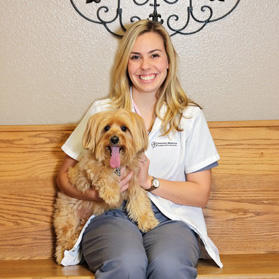Fleas- Small Insects that can Cause Big Problems


Dr. Mary Beth Tamor
In our veterinary office, we are commonly asked about fleas. Pet owners can usually detect the issue, but do you know it can be a bigger problem than just Fido scratching?
What do they look like?
We will focus our talk on the most common flea we come into contact with: Ctenocephalides felis. It may be known as the cat flea, but it is the flea found in 99.9 percent of our pets including: cats, dogs, and rabbits. They are very small and narrow which allows them to move easily between hairs and while flightless, fleas are extraordinary at jumping. They can jump as high as 50 times their own body length. One last important feature to note is their mouthparts that pierce skin and allow the flea to suck blood.
Their Life Cycle
Fleas have 4 life stages consisting of egg, larval, pupal and adult stages.
- Eggs are laid into a pet’s hair, bedding, and cracks. They hatch in about 1 week and form larvae.
- Larvae are immature fleas. They are worm-like and live on organic matter such as dried blood and adult flea feces. Larvae mature into the pupal stage in about 12 days.
- Pupae are resistant to freezing and drying and can lie dormant for months.
- Once an adult, fleas begin feeding on fresh blood. The entire life cycle can be completed in just 3 weeks.
Why are they a problem?
We all know fleas are annoying but our pets and ourselves can be seriously affected.
- Fleas suck blood. Blood loss from fleas can lead to anemia in young or small animals or with a heavy burden.
- Fleas can cause skin irritation. If a pet is allergic to fleas, severe itching can cause self-traumatization seen as skin infections and hair loss.
- Fleas can carry and transmit a number of diseases in both animals and humans including Mycoplasma haemofelis, Bartonella henselae (cat scratch fever) and tapeworms.
How can we control them?
It is important to understand the flea life cycle in order to obtain adequate control. Aiming at both the adult stages and the egg/larval stages is key. There are many options on the market today including topical spot on’s, orals and collar products. Talking to a veterinarian can help you make the best decision for you and your pet.
Common Flea Myths
Myth: Inside pets aren’t at risk to have fleas.
• Fact: Fleas are able to live and thrive in home so even indoor only pets are at risk.
Myth: Fleas aren’t seen, therefore there are no fleas.
• Fact: Fleas aren’t always visible since many pets will lick or chew themselves after being bitten by a flea. The flea then jumps off or is swallowed by the pet.
If fleas are a concern within your household we have plenty of products that can help. Call or visit us today, one of our representatives can help you pick a flea product tailored to your pet’s needs. Animal Care Center- (985)542-6300 Pet Care Center- (985)370-7387
